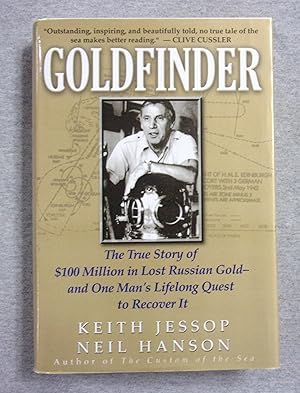The True Story of $100 Million in Lost Russian Gold -and One Man's Lifelong Quest to Recover It
Keith Jessop and Neil Hanson
"Outstanding, inspiring, and beautifully told. No true tale of the sea makes better reading."-Clive Cussler
Here is the true tale of a small-time salvage diver, the crushing depths of the sea, and the richest prize ever found-$100 million in pure gold. Follow salvage diver Keith Jessop as he battles nature, governments, traitors, salvage monopolies, and, of course, lawyers to claim the grand prize of wrecks-the HMS Edinburgh. Filled with ten tons of Russian gold, the ship had been sought by many, but never found. Through unyielding determination, extraordinary physical prowess, and keen intelligence, Keith Jessop risks all to reach his final destination, and keeps readers on the edge of their seats.
Jessop's energetic rags to riches to rags saga more resembles a Dickens novel than the introspective, spiritual or ironic efforts that glut the adventure-book market. Born to a poor Yorkshire mill girl and a Depression-era "spotty youth," Jessop, with coauthor Hanson (The Custom of the Sea), describes his happenstantial discovery of the pleasures of the sea and his early job salvaging scrap metal from shipwrecks. He goes from English harbors to various parts of the world during a more than 40-year career as a self-styled deep-sea diving expert ("The more I understood about the physics of diving, the more horrified I was by some of the risks I had already taken"). After he begins his own salvage company, which he often supplements with dangerous work drilling oil in the North Sea, Jessop's biggest opportunity arises when he obtains rights to salvage for more than $100 million in gold in the sunken British war vessel HMS Edinburgh. In the ensuing adventure, Jessop has to work with shady governmental types in a British-based consortium to salvage the wreck. He discovers the gold, then spends two years defending himself against groundless charges of conspiracy to defraud the same sleazy types who gave him trouble getting the operation started. The book ends with Jessop out of work, not very wealthy and separated from his wife. But his determination "that the bastards were not going to grind me down" serves as his mantra and as stitching between the various parts of this enjoyable book. 15 photos.
Copyright 2001 Cahners Business Information, Inc.
Jessop, who grew up in England during the 1940s, has written a fascinating narrative of the discovery and salvage of $100 million in Soviet gold from the HMS Edinburgh, sunken in 1942 by German ships 830 feet below the Barents Sea. Unhappy with a job in the local textile mill, Jessop discovered that he could make a living diving the coastal waters and salvaging non-ferrous metals from shipwrecks. Always a step ahead of his creditors, he discovered that researching the location of wrecks and legally obtaining the salvage rights was an important part of the job. To gain deep-diving experience, he landed a job as a commercial diver working on oil rigs in the North Sea. He soon became expert in saturation diving, a technique that allows divers to remain in pressurized chambers for long periods. Co-written with experienced writer Hanson (The Custom of the Sea), this book is a thoroughly detailed account of Jessop's diving experiences. It is especially good when discussing how Jessop gained the salvage rights from the Russian government and made the necessary business arrangements to support the costly recovery. Even though Jessop did get his share of the gold, he wound up losing most of it in legal disputes with his business partners. For all armchair treasure hunters in public libraries. John Kenny, San Francisco P.L.
Copyright 2001 Reed Business Information, Inc.
